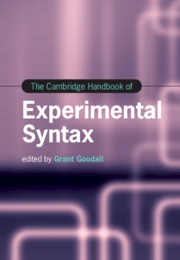Book contents
- The Cambridge Handbook of Experimental Syntax
- The Cambridge Handbook of Experimental Syntax
- Copyright page
- Contents
- Figures
- Tables
- Contributors
- Introduction
- Part I General Issues in Acceptability Experiments
- Part II Experimental Studies of Specific Phenomena
- 8 Resumptive Pronouns in English
- 9 Island Effects
- 10 The That-Trace Effect
- 11 Anaphora: Experimental Methods for Investigating Coreference
- 12 Constituent Order and Acceptability
- 13 Acceptability Judgments at the Syntax–Semantics Interface
- Part III Experimental Studies of Specific Populations and Language Families
- Part IV Experimental Syntax beyond Acceptability
- Index
- References
13 - Acceptability Judgments at the Syntax–Semantics Interface
from Part II - Experimental Studies of Specific Phenomena
Published online by Cambridge University Press: 16 December 2021
- The Cambridge Handbook of Experimental Syntax
- The Cambridge Handbook of Experimental Syntax
- Copyright page
- Contents
- Figures
- Tables
- Contributors
- Introduction
- Part I General Issues in Acceptability Experiments
- Part II Experimental Studies of Specific Phenomena
- 8 Resumptive Pronouns in English
- 9 Island Effects
- 10 The That-Trace Effect
- 11 Anaphora: Experimental Methods for Investigating Coreference
- 12 Constituent Order and Acceptability
- 13 Acceptability Judgments at the Syntax–Semantics Interface
- Part III Experimental Studies of Specific Populations and Language Families
- Part IV Experimental Syntax beyond Acceptability
- Index
- References
Summary
This chapter reviews the theoretical and conceptual issues central to acceptability judgment tasks, and related paradigms, at the syntax–semantics interface, and provides a broad overview of core results obtained from research in this domain. Challenges faced by studies in experimental semantics are distinct from those in experimental syntax, which at times requires different linking hypotheses, research questions, or experimental paradigms. However, the current state of affairs suggests that acceptability and other offline judgments will continue to contribute highly informative and profitable tools for exploration of phenomena at the syntax–semantics interface.
- Type
- Chapter
- Information
- The Cambridge Handbook of Experimental Syntax , pp. 341 - 370Publisher: Cambridge University PressPrint publication year: 2021



